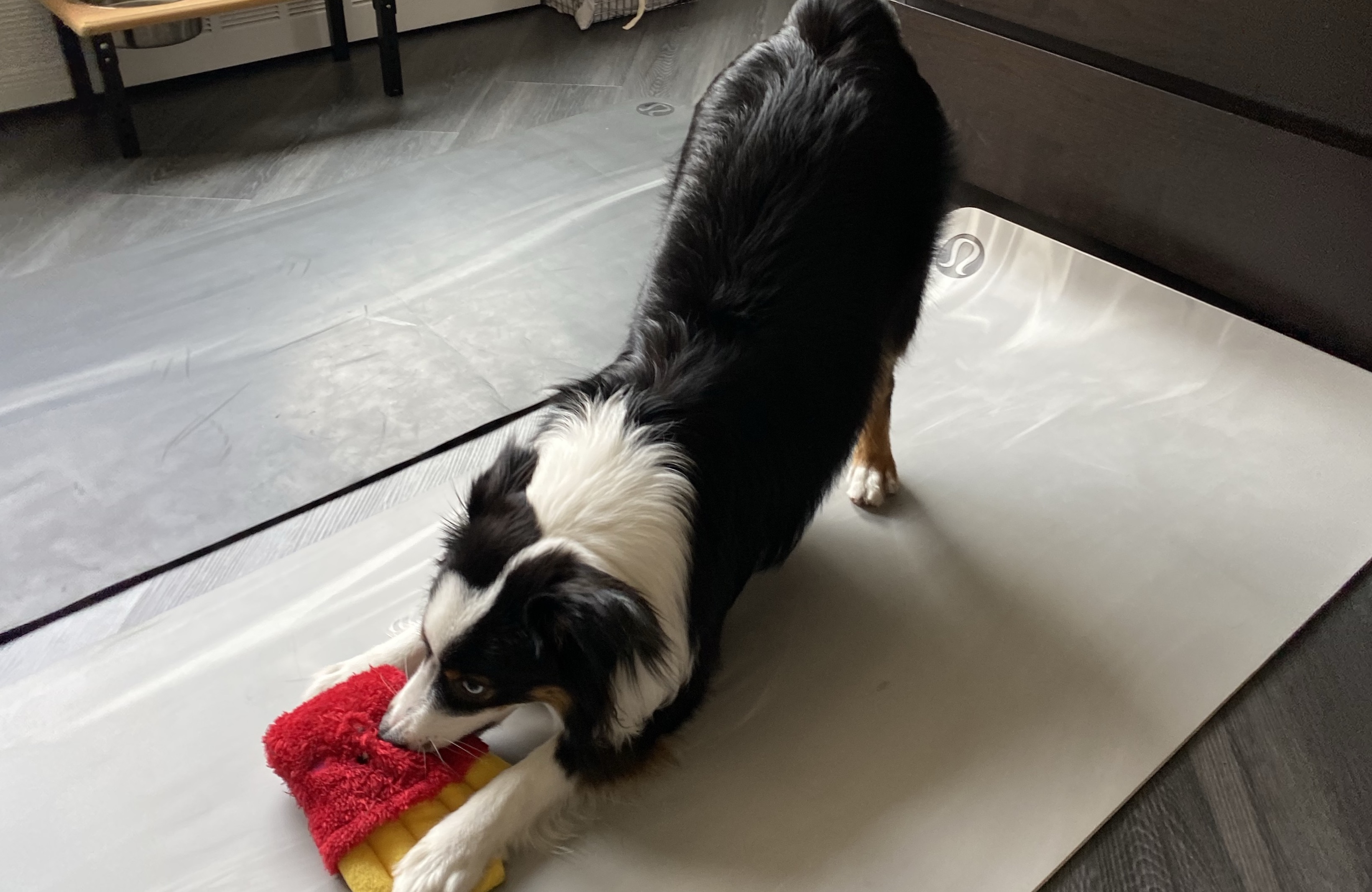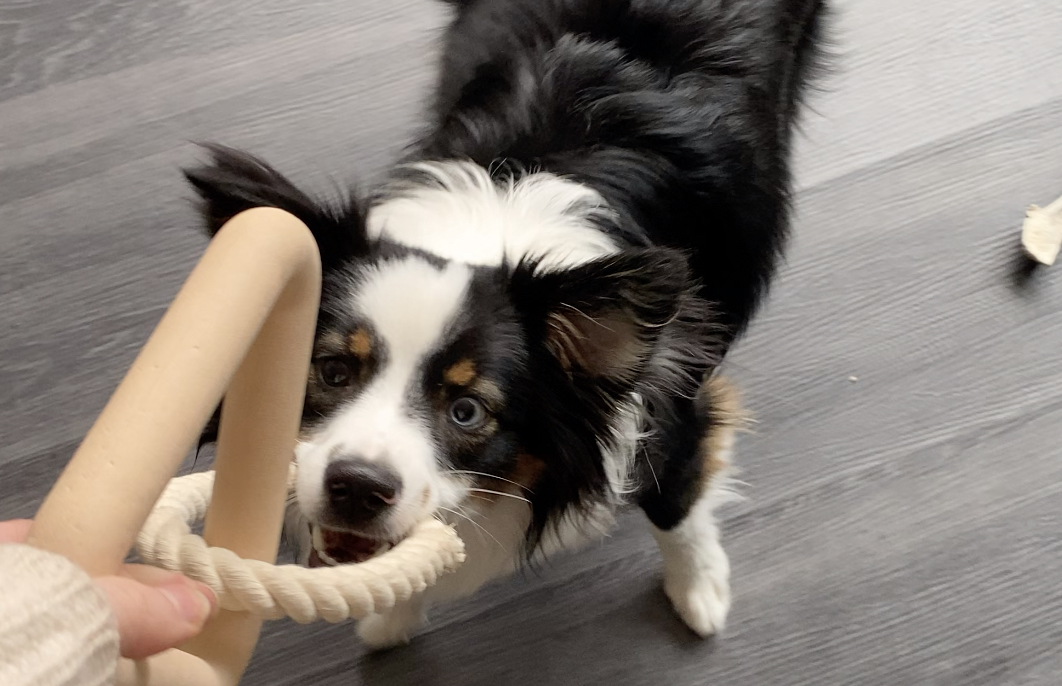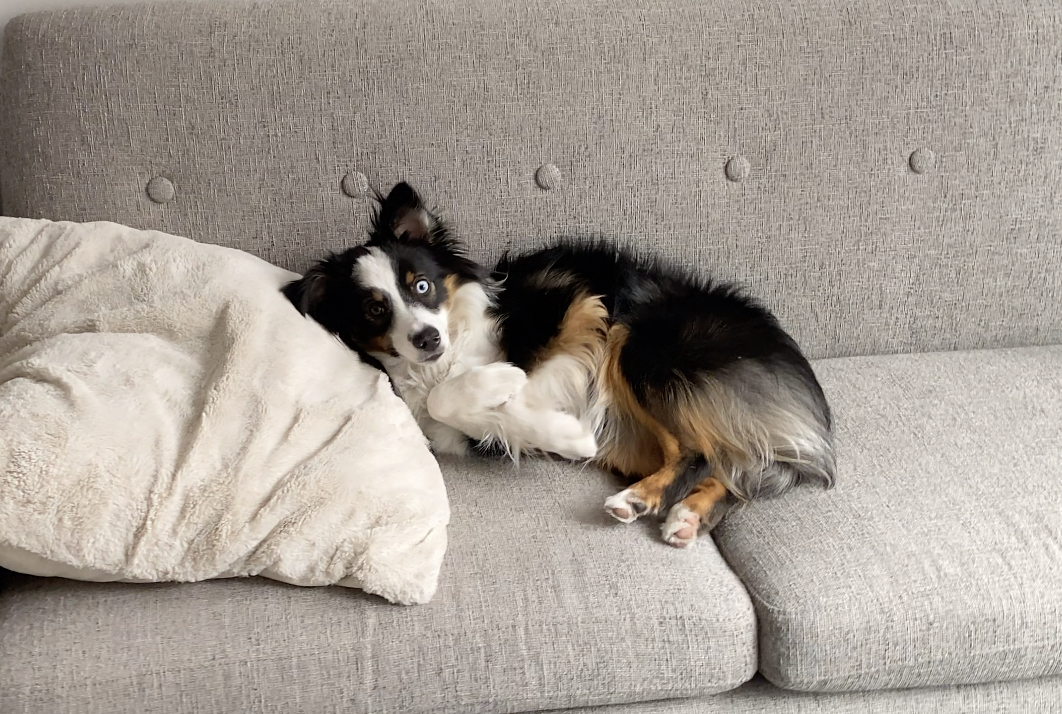Nearly everyone’s daily life has been affected by COVID-19 and the social-distancing measures used to combat its spread. That includes our dogs.
On one hand, for those able to work at home, you’re giving your dog their fondest wish—having you around all day! But though they may not be able to watch the news, dogs can certainly pick up on the increased levels of stress or anxiety in the household, and they can be affected by the dramatic changes in their daily routine.
Here are some expert-approved tips for keeping your dog happy, safe—and, of course, healthy—as you practice social distancing.
Health and Safety
First and foremost, pet owners should keep in mind that all indications are that dogs cannot catch and spread coronavirus the same way people can (read more about COVID-19 and your dog here). Experts do believe that the virus could potentially live on pets’ skin or coat, and be transmitted through contact, but the same experts say transmission in this way is unlikely. Contamination via a surface, or “fomite,” is not thought to be the primary means of transmitting COVID-19. And smooth surfaces (like countertops) transmit viruses better than porous materials. The American Veterinary Medical Association notes on its site, “Because your pet’s hair is porous and also fibrous, it is very unlikely that you would contract COVID-19 by petting or playing with your pet.” As the AVMA’s chief veterinary officer told the The Washington Post, “We’re not overly concerned about people contracting COVID-19 through contact with dogs and cats.”
That said, it’s best to maintain social distance on behalf of your dog. The safest practice (and this one’s a bummer) would be to avoid petting dogs other than your own, and to prevent people outside of your household from petting your dog.
Prepare now for unknowns
As you’re stocking up on beans and paper towels, don’t forget supplies for your dog. Make sure you have ample food and medications available for all pets in case you can’t easily get out for an extended period of time, such as in the case of elderly pet owners, or, if stricter quarantine practices go into effect. “If you have a family or friend that is a senior or is ill, try to think about their dog and how you can help them,” adds Scott R. Sheaffer, a certified canine behavior consultant and owner of USA Dog Behavior in Texas.
It’s also a good idea to have an emergency plan for your dog. Sheaffer recommends either identifying a boarding facility or lining up care with a close family member or friend in case it becomes necessary. “If you or someone in your family gets sick and you find yourself struggling to take care of your dog, the last thing you need to be worried about is scrambling around to find somewhere for your dog to go,” he says.
For anyone who is out of work and having trouble with the financial commitment of their pets, Sheaffer recommends tapping into resources like The Humane Society of the United States’ site, which provides a list of organizations working to help pet owners address these issues.
Lastly, be sure to educate yourself on what your veterinarian is doing to help protect both pet patients and their owners during this time. While some veterinary practices have temporarily closed, the ones that are open may have changed their procedures, such as asking owners to stay in the car or on the curb and having a member of their staff bring the dog inside for exams or treatment.
“Some veterinarians are even participating in telemedicine, so if your dog is having a health issue, don’t hesitate to call and get help directly over the phone,” Sheaffer says.
Keeping dogs physically active
If you look around some cities, it seems that our dogs are getting more exercise than ever before—with little else to do, many families are going for multiple walks a day. If you are still able to safely walk outside, and observe all public safety measures, keep at it. Walking is an important part of your dog’s routine. “The reason we take dogs for walks is for mental and physical stimulation,” says Blake Rodriguez, trainer and founder of Dream Come True K9 in New York. “Go to the places you usually go. Go to the beach if you live near the beach—obviously being careful to keep your distance. It’s important to allow dogs to sniff.”
The 2020 Indoor Games
For anyone who isn’t able to take advantage of the outdoors due to physical constraints, or tightened social-distancing policies, there are lots of ways to ensure that your dog is getting the exercise they need to stay healthy.

Home gym: If you have access to hallways and stairs, they can provide some essential exercise. Some hallway fetch can provide a welcome break for both of you. It may even be a chance for you to actually teach your dog fetch. As Barbara Johnson, a canine behavior specialist, trainer, and owner of BJK9 Positive Dog Behavior Training in California, notes, fetch isn’t something that all dogs automatically know how to do. If you can, you may wish to consult a certified dog trainer (many are offering virtual sessions and behavioral support right now and would likely appreciate the assignment), or do some research on how to teach them to retrieve and bring back a toy. Practicing indoors is a safe way to tackle this.
Stair climbing can be an effective way to get in some reasonably high-intensity exercise while stuck indoors. Put a toy or treat at the top of a set of stairs and have your dog retrieve it and come back to you (and repeat). If you live in an apartment building, you can take the elevator down a number of floors and walk up (use your, and your dog’s, fitness as a guide to how many floors, and how fast, you ascend). Make sure your dog is healthy enough for this activity (avoid if there are any joint or eyesight issues) and ensure they’re suited to tackle any stairs–breeds with longer backs and shorter legs may not be. And, establish whether or not they actually enjoy it. “If the dog is physically able and enjoys it, stair climbing is definitely good exercise, but be sure your dog thinks it’s fun and wants to engage in that behavior,” Johnson says. “There’s nothing worse for any of us right now than being forced to do something we don’t like.”
If you have the space and resources, and a dog who needs an abundance of exercise, consider a treadmill. Be sure to start slow, never tether your dog to the equipment, and supervise them at all times.
Tug, mindfully: With limited space and resources, get creative, says Rodriguez. “Find what motivates your dog.”
You don’t need a lot of space for a game of tug, which has the added benefit of providing both you and your dog with a burst of good exercise in a short amount of time. However, Rodriguez says, the game must be played on your terms. “Add rules to play tug,” he says. “With adding rules, you have your dog ‘go to place,’ or sit, or ‘down’ when you want them to. So, you can have a dog that can tug, tug, tug, tug, and then when you say so, the dog releases the tug. Then the reward for that marker is the dog gets to re-engage and start the game again.”

Beyond games of tug, this boundary-setting is a key part of keeping your dog happy during, and after, this unusual situation. It’s great to keep your pet mentally and physically engaged, but it’s also important to not overdo it. Jean Owen, certified dog trainer and owner of Fix My Dog in New Jersey, notes that too much play or attention can actually lead to anxiety and hyperactivity in some dogs. “Pet owners need to keep in mind that their dog needs some down-time, preferably alone,” she says. Keep to routines instead of creating a playtime free-for-all.
Mental stimulation and well-being
Just as many of us are feeling stir-crazy these days, our pets aren’t immune to feeling anxious, scared, and—let’s face it—bored. Offering your dog intervals of mental stimulation helps keep them happy, reduces the chance of unwanted behavior, and can have the (positive) effect of tiring them out.
CAVEAT: It’s essential that you manage your dog’s weight during a time when they may be getting less exercise than normal. Treats should make up no more than 10% of a dog’s daily diet (read more about weight maintenance here). If you’re playing games with treats, use healthy single-ingredient options like small pieces of carrot or celery. If you need more, or need something more aromatic, try taking small portions of your dog’s food and fashioning it into treats. Fresh food works great for this purpose! Take tiny scoops and bake into crunchy morsels.
Food-puzzle toys
There’s no shortage of toys on the market that can provide stimulation by turning everyday activities into “work.” Kongs and other food-puzzle toys are a great choice because they turn treat- and meal-dispensing into a mental and physical challenge for your dog. For something outside of the usual treat options, Johnson recommends Chamomile tea. After bringing brewed tea to room temperature, pour it into a Kong and freeze it, then give it to your dog to lick. “The same soothing properties in Chamomile tea (that work in people) also transfer to your dog,” she says.
Johnson also suggests LickiMats, which apply the same sort of delayed-gratification principle. You can smear moist food or healthy treats into the grooves of the mats, which keeps dogs engaged as they work to lick up every bit.
Snuffle mats give your dog the chance to do some detective work with their keen noses. Made from strands of fabric attached to a strong backing, they’re designed to replicate the experience of “hunting” through deep grass to find treats and other treasures. There are several commercially available types, or if you enjoy a craft project, there are lots of online tutorials to walk you through the process of making one.
Homemade games
There are lots of other mind-body games you can improvise with things you already have at home.
Hide and seek: Your dog experiences so much of the world by smell, so lean into the olfactory when devising games. Go-to games like Hide and Seek, according to Sheaffer, are a great way to exercise your dog’s mind, body, and recall skills. Hide treats or coveted objects around the house. Tracking them down will keep your dog busy, and burn mental and physical energy. Johnson also notes that the game can be a way of distracting your dog from you. “The biggest thing I’m concerned with is that most dogs are accustomed to us not being home, and now that we are home, they’re following us everywhere,” she says. “We don’t want to deal with separation anxiety and velcro dogs later. So, by hiding things in different rooms, if they’re following you around the house they can get distracted by these other things and other scents.”
Box games: Rodriguez recommends using the boxes from online orders for nose games. With your dog in another room, hide treats in one of a handful of boxes. Then let your dog sniff their way to the reward. “Have your dog sitting or “on place” before you start the game and release them to start searching,” says Rodriguez. “But again make sure YOU are the one initiating the game. You don’t want it to lead to a dog that is pestering you, or becoming anxious, or setting the time and place for you.”
Training days
One bit of good news for pet owners is that the extended time at home can provide ample opportunities to work on long-term training. So if you’ve been dealing with any undesirable behaviors, or you’ve always wanted to work on a particular skill, now might be a great time. “At this point in time, with all of us in seclusion, any dog can be trained and will benefit, regardless of their age,” Johnson says. Many trainers around the country are offering virtual training—get in touch with your trainer, or look up a certified trainer in your area (see resources at the end of this page).
If your dog has a tendency to “door dash,” for example—when someone approaches your home and the dog starts barking, rushes them, or, worse, runs into the street—you can work on behaviors like sitting and remaining in a designated spot when the front door opens or the doorbell rings. “It takes about six weeks for something like this to really work—but we have that time now,” Johnson adds. “You can start slowly; nothing should be rushed, as everything takes time, patience and consistency.”
Other types of commands, like recall, are always good to refresh, and you can turn these training sessions into stimulating games for your dog. Position yourself on one end of the house and practice getting your dog to come to you when called (and, of course, reward them appropriately with a healthy treat or toy).
Another way to keep your dog’s mind sharp while we’re all stuck at home is what Sheaffer calls “Cue Review”—a 15-minute review of all the tricks or commands you’ve taught your dog, such as come, down, and sit. “This can be both a physical and mental exercise for your dog, but be careful not to have sessions last longer than about 15 minutes,” he adds.
Owen adds that you can also work on fun tricks like backing up, which can be done indoors in a hallway—stand in front of your dog and walk towards them, and when they back up, treat them, she explains. “You can even incorporate a fun command for this behavior—my dogs back up when I say ‘beep, beep, beep,’” she adds.
Keeping behavioral issues at bay
With everyone now home all the time, it’s also important to work on teaching your dog to be calm—which may be more of a challenge for younger, energetic dogs who are always ready to play. “If we’re sitting and watching a movie, the dog needs to learn to be on the floor or the couch quietly, because not every moment is a moment of play,” Johnson says. “Dogs may think, ‘my human is home, let’s play and play and play some more!’ But that’s not why we’re home…and dogs need to understand that there’s a time and place for everything.”
Keep or establish routines
Everyone’s lives and daily routines have been turned upside down during this period, but it’s important to maintain at least some semblance of your dog’s normal routine in order to prevent behavioral issues such as separation anxiety. “It’s a good time for humans to stay organized and create an itinerary of time and place to keep to your routine,” says Rodriguez. “It’s not only helpful to prevent a dog becoming anxious; it’s helpful for us to retain our sanity.”
That means setting aside some time for your dog to be alone, or even crated, if that’s part of their normal routine, as well as keeping regular feeding times, bathroom breaks or walks. While Sheaffer says dogs won’t necessarily develop separation anxiety if they don’t already have this issue, “we also can’t expect them to go from having us home 24 hours a day to being stuck in a crate by themselves when you go back to work,” he says. “If nothing else, it’s almost certainly going to cause them a great deal of stress.”

Our dogs also have to learn that life hasn’t changed THAT much, says Johnson. “There are times that our dogs have to be left alone. Many people are developing their own mental stress with this seclusion and our dogs are giving us comfort. But we still have to go about our daily business the best we can so we’re not doing harm to our dogs long-term.”
And dog owners should also keep in mind that while one of the true wonders of dogs is how much comfort they can be in this time of uncertainty, they may feel stress too. “Many of my clients aren’t really aware of how much they’re relying on their dog to feel better. We automatically hug our dogs when we cry and look to them as almost a form of therapy, but if everyone in the house is leaning on the dog, he can become overwhelmed with anxiety,” Owen says. “Families need to use moderation when it comes to how often they’re turning to their dogs for comfort right now.”
Step outside
Even if you can’t leave the house for extended periods, it’s a good idea to leave, even if just for short intervals, or arbitrary reasons. Take a call outside, go for a solo walk, or walk a few flights of stairs. “Controlled bouts of separation are the kindest thing you can do for your dog right now,” Owen says, noting that many clients are calling because their dog is suddenly exhibiting new behaviors, such as scratching at the door, whining, or pacing. “It’s generally because now they’re used to having their pack together all the time; so now if Mom or Dad runs to the grocery store, they’re getting anxious and displaying all of these anxious behaviors they normally wouldn’t,” she adds.
Maintain boundaries
The experts we spoke to emphasized the importance of the sense of “time and place,” and establishing some rules of behavior, even in a highly atypical situation. When you’re inside, keep boundaries. “Be aware that, yes, there is a plus side to all of this—you can engage and be active and work on things now that you are home,” says Rodriguez. “But at the same time, you do want to be careful. What may happen is that you create a breeding ground for anxiety. When you have a dog who is with you, around you, on top of you 24/7, it might seem fine right now. But if you’re not setting up your dog so they understand there’s play time, there’s engagement time—that you are initiating—but that when we’re done, there is also some separation time, it can create problems. That doesn’t necessarily mean the dog is confined physically by a crate or a room. It can just be a rule that is being implemented by the human that says, ‘OK, I want you over here when I’m cooking or watching TV or sitting on the couch.’”
That separation can be tough when we want to spend as much quality time with our dogs as we can. “Even though some people might LIKE their dog sitting on their lap, it’s a really good thing to practice time and place,” says Rodriguez. “And now is a better time to do it than ever. A dog realizing that when you’re around they do not HAVE to be around or on top of you, that’s beneficial.”
While this period is challenging for humans and dogs. Rodriguez notes one other opportunity it provides: empathy. “It allows people to feel for their dogs who are at home while they are at work. Dogs go for a walk around the same block every day and then come home. So if you’re starting to go stir-crazy, think of how your dog feels every day. It’s a nice time to see things from the dog’s POV and be a bit more considerate and start to include them in more activities than we might have previously.”
Resources:
For more tips, and to find trainers in your area:
The Association of Professional Dog Trainers
International Association of Canine Professionals
The Certification Council for Professional Dog Trainers
For more information on coronavirus and pets:
The AVMA coronavirus info page









